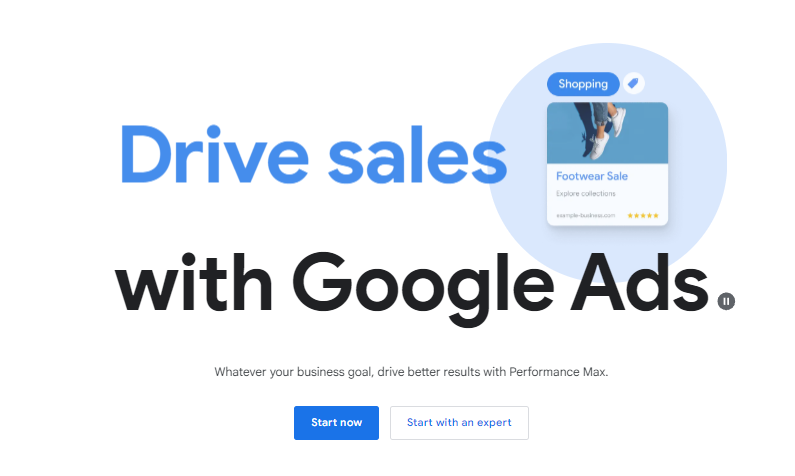December 6, 2024
Google Advertising for Startups: Maximize Your Potential

Greg Kopyltsov
Founder
google advertising for startups

In today's digital landscape, establishing a strong online presence is crucial for startups to thrive. Digital marketing plays a pivotal role in reaching target audiences effectively. For startups looking to jumpstart their growth, creating a Google Ads account is an essential step. This blog post will guide you through the intricacies of Google Ads, providing you with the knowledge and tools to launch successful advertising campaigns and propel your startup toward success.
Google Ads is an advertising platform developed by Google, where advertisers bid to display brief advertisements, service offerings, product listings, or videos to web users. It can place ads both in the results of search engines like Google Search and on non-search websites, mobile apps, and videos.
One of the most significant advantages of this advertising platform is its ability to connect businesses with their desired target audience. Google Ads allows startups to target their ads based on various factors, such as demographics, interests, location, and online behavior. By reaching the right people with tailored messaging, startups can increase their visibility, generate leads, and ultimately drive conversions.
As a startup, it's probable that you're working with limited resources. With this in mind, it's important to make sure you're using those resources as strategically as possible. This makes having a solid marketing strategy essential to reaching your growth goals. Google Ads can play a significant role in a startup's marketing strategy by addressing various aspects of growth, including:
Now that you have an understanding of the pivotal role Google Ads can play in a startup’s marketing strategy, let’s discuss some key advantages:
Before you dive headfirst into Google Ads, there are some crucial steps to take and factors to consider in order to maximize your efforts and increase the chance of running a successful campaign. This includes setting clear and achievable advertising objectives that align with your overall business goals as well as setting a realistic budget that accommodates your startup’s financial capabilities.
Failing to define your objectives clearly can lead to ineffective campaigns and wasted ad spend. Careful budget planning ensures that your campaigns are financially sustainable and optimized for long-term success.
Clearly identifying your marketing goals is a critical initial step in maximizing the effectiveness of your advertising campaigns. Start by asking yourself what you aim to achieve through Google Ads. Are you aiming to boost brand awareness, drive traffic to your website, generate leads, or increase sales?
Each of these goals requires a different approach and strategy. For instance, if your primary objective is to heighten brand awareness, you'll focus on maximizing ad impressions and reach. Conversely, if your goal is to generate leads or boost sales, your focus should shift towards optimizing for conversions.
By precisely outlining your advertising goals, you lay a strong foundation for creating highly targeted campaigns that generate a higher return on investment (ROI). It allows you to allocate your budget effectively, choose the right ad formats, and tailor your messaging to resonate with your target audience's specific needs and interests.
Once your objectives are clearly outlined, it's essential to outline a comprehensive budget for your advertising endeavors. This step is especially critical for small businesses and startups operating with limited financial resources. However, it's important to note that Google Ads caters to businesses of all sizes, offering flexibility in setting your monthly budget.
Start by determining a comfortable daily or monthly budget that aligns with your startup's financial capabilities. Remember that the cost of advertising can vary significantly depending on numerous factors, including competition, industry, location, and targeted keywords. During the initial stages of your Google Ads journey, it's generally recommended to start with a smaller budget. As you gather data, optimize your campaigns, and gain a deeper understanding of cost dynamics, you can gradually increase your spending.
By diligently planning your advertising budget, you mitigate the risk of overspending and ensure that your campaigns remain within a manageable financial scope.
Setting up and running Google Ads might feel overwhelming for beginners. Don't worry, just take it one step at a time and you'll be a pro in no time! We'll break down the process of launching your first campaign into four easy-to-follow steps:
By following these steps diligently, you'll set a strong foundation for your Google Ads journey. Remember that consistency is key in the world of online advertising, and continuous learning and optimization are essential to achieving sustainable success.
The first step to harnessing the power of Google Ads is to create an account. Creating a Google Ads account is a simple and quick process. Simply head over to the Google Ads website and click on the "Start Now" button.
You'll be asked to provide some basic information, such as your email address, website, and billing information. Once you've created your account, you'll be taken to your dashboard. From your Google Ads dashboard, you can manage your campaigns, track their performance, and make changes as needed. Your dashboard is your central hub for everything Google Ads related, providing a comprehensive overview of your advertising activities. You'll also be prompted to set up your first campaign. Select your campaign goal, target audience, budget, and ad formats. Ensure to set a strong password and enable two-factor authentication to enhance the security of your account.
Choosing the right target keywords is paramount to the success of any Google Ads campaign. Keywords act as the bridge connecting your ads with potential customers actively seeking the products or services you offer. They are the terms that users enter into search engines like Google when they're looking for information, products, or services.
Fortunately, Google provides a handy tool called Keyword Planner to assist in keyword research. The Google Keyword tool offers valuable insights into search volume, competition, and suggested bids for specific keywords. It provides an estimated range of how much advertisers are paying per click for a particular keyword, giving you an idea of the competitiveness and potential cost. Begin by brainstorming a list of relevant search terms that potential customers might use when searching for your products or services. You should also explore long-tail keywords, which are longer and more specific phrases. Long-tail keywords often have lower competition, making them an excellent option for targeting a niche audience and driving qualified leads.
With your keywords carefully selected, it's time to craft your ad copy. Your ad copy is the text that potential customers will see when your ad is displayed. Compelling and persuasive ad copy is essential to capture users' attention amidst the vast sea of online advertisements. It's crucial to adhere to best practices when creating your first ad:
In addition to these tips, consider using negative keywords to refine your targeting further. Negative keywords are words or phrases that prevent your ads from being triggered by irrelevant search terms, improving campaign efficiency and reducing wasted ad spend. Group your ads into relevant ad groups based on themes, products, or services. This practice improves the organization and management of your campaigns while ensuring that your ads are displayed to the most relevant audience segments.
Launching your campaigns is only half the battle; the true key to success lies in diligently monitoring their performance and making necessary adjustments along the way. Google Ads provides robust analytics and reporting tools that furnish invaluable insights into how your campaigns are performing. You can monitor metrics like click-through rate (CTR), conversion rate, cost-per-click (CPC), and overall ROI.
Regularly review your campaign data to glean actionable insights. Identify top-performing keywords, ad copy, and landing pages and leverage this data to optimize underperforming elements. Consider using A/B testing to experiment with different ad variations, landing pages, and even bidding strategies. Through continuous A/B testing, you identify what resonates best with your target audience and optimize for maximum conversions and return on investment.
Unlocking the true potential of your Google Ads campaigns requires moving beyond the basics and implementing strategies to optimize for higher efficiency and better results. This involves a keen understanding of certain factors that can significantly influence your campaigns' performance.
One crucial factor is the Quality Score, a metric used by Google to determine the relevance and quality of your ads and landing pages. The components of Quality Score include expected click-through rate (CTR), ad relevance, and landing page experience, which should be optimized to improve your score. Maintaining a high Quality Score can lead to lower ad costs and better ad positions. Another essential aspect is understanding the search intent behind keywords. By aligning your ads and landing pages with user intent, you can improve your ad's relevance and increase your conversion rate.
Regular analysis of your campaign performance is vital for identifying areas of improvement and maximizing your return on investment (ROI). Understanding how users interact with your ads, navigate your landing pages, and convert into customers is fundamental to refining your strategies and improving overall efficiency.
Begin by diving deep into the analytics provided within your Google Ads dashboard. Carefully examine vital metrics like click-through rate (CTR). This will reveal which keywords and ad copy effectively captured the attention of your audience and led to clicks, while a low CTR may indicate a disconnect between user intent and ad messaging. Pay close attention to your conversion rate – the percentage of users who completed a desired action, such as making a purchase or signing up for a newsletter.
Evaluate your cost-per-click (CPC). A high CPC may indicate fierce competition for specific keywords, while a low CPC suggests room for bid adjustments or improved Quality Score.
Google AdWords offers a variety of advanced features to further optimize your campaigns. You can use location targeting to ensure your ads are seen by people in specific geographic locations. If your startup caters to a particular age range, you can leverage age targeting. This feature allows you to connect with users within your preferred age bracket, enhancing the chances of converting them into customers.
Here’s a breakdown of different Google Ad formats and what they can offer:
Ad format
Description
Benefits
Search Ads
Text ads shown on Google's search results page
Target users actively searching for products/services.
Display Ads
Visual ads shown on websites within the Google Display Network
Build brand awareness & retarget potential customers.
Video Ads
Videos shown on Youtube and other platforms.
Engage users with compelling visuals and storytelling.
By experimenting with different ad formats, you can appeal to a wider range of customers and discover what works best for your brand.
KeywordSearch has an AI Audience builder that helps you create the best ad audiences for YouTube & Google ads in seconds. In a just a few clicks, our AI algorithm analyzes your business, audience data, uncovers hidden patterns, and identifies the most relevant and high-performing audiences for your Google & YouTube Ad campaigns.
You can also use KeywordSearch to Discover the Best Keywords to rank your YouTube Videos, Websites with SEO & Even Discover Keywords for Google & YouTube Ads.
If you’re looking to SuperCharge Your Ad Audiences with AI - Sign up for KeywordSearch.com for a 5 Day Free Trial Today!
Google Advertising can be a game-changer for startups looking to boost growth. By strategically leveraging Google Ads, you can reach your target audience effectively and drive conversion rates. Understanding your advertising objectives, budget planning, and crafting compelling ads are crucial steps in setting up successful campaigns. Regular monitoring and adjusting based on performance insights are key to maximizing efficiency. Remember, Google Ads can work for various types of startups, but results may vary based on competition and targeting. Avoid common mistakes, leverage advanced features, and continuously optimize to see significant results in your startup's growth journey.